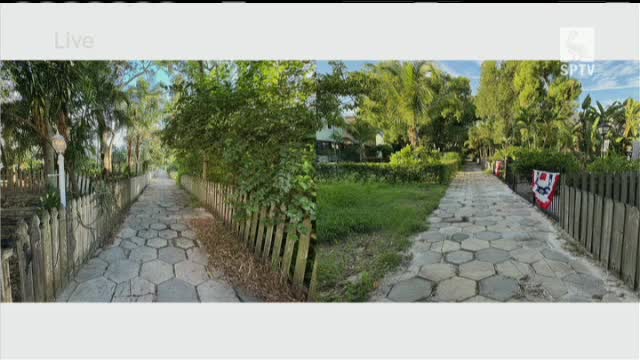Homeowners clash with preservationists over historic yard redesign
August 13, 2024 | Saint Petersburg City, St. Petersburg County, Florida
This article was created by AI summarizing key points discussed. AI makes mistakes, so for full details and context, please refer to the video of the full meeting. Please report any errors so we can fix them. Report an error »

In a recent government meeting, discussions centered around a proposed redesign of a front yard at Lang's Bungalow Court, a historic neighborhood in Southern California. The proposal, presented by resident Robert Castellucci, aims to enhance safety and functionality for his family while maintaining the area's historic character.
Castellucci's plan includes replacing an existing 18-inch hex block paver walkway with a new seven-foot wide version, installing a 930-square-foot patio, and replacing a three-foot wood picket fence with a six-foot vinyl fence. He emphasized the need for a secure and private outdoor space for his young children, citing a past incident where his daughter nearly wandered into a busy street due to a compromised fence.
The staff report, however, recommended denial of the proposal, arguing that the changes would detract from the neighborhood's historic aesthetic. Staff noted that the use of vinyl fencing is not traditional for the area, and that the proposed patio and pavers could disrupt the central garden concept characteristic of early 20th-century bungalow courts.
Castellucci countered these concerns by highlighting the importance of security and privacy in a densely populated area, particularly given the proximity of short-term rental properties and a local food pantry. He expressed a willingness to compromise on materials, suggesting aluminum fencing as an alternative to vinyl, and proposed the installation of lighting to enhance safety and ambiance.
The commission's decision will weigh the need for modern family amenities against the preservation of historic integrity. As the meeting concluded, Castellucci reiterated his commitment to balancing the neighborhood's historic charm with the practical needs of contemporary living, seeking support from neighbors to bolster his case. The outcome of this proposal could set a precedent for future alterations in historic districts, reflecting the ongoing challenge of adapting heritage sites to modern lifestyles.
Castellucci's plan includes replacing an existing 18-inch hex block paver walkway with a new seven-foot wide version, installing a 930-square-foot patio, and replacing a three-foot wood picket fence with a six-foot vinyl fence. He emphasized the need for a secure and private outdoor space for his young children, citing a past incident where his daughter nearly wandered into a busy street due to a compromised fence.
The staff report, however, recommended denial of the proposal, arguing that the changes would detract from the neighborhood's historic aesthetic. Staff noted that the use of vinyl fencing is not traditional for the area, and that the proposed patio and pavers could disrupt the central garden concept characteristic of early 20th-century bungalow courts.
Castellucci countered these concerns by highlighting the importance of security and privacy in a densely populated area, particularly given the proximity of short-term rental properties and a local food pantry. He expressed a willingness to compromise on materials, suggesting aluminum fencing as an alternative to vinyl, and proposed the installation of lighting to enhance safety and ambiance.
The commission's decision will weigh the need for modern family amenities against the preservation of historic integrity. As the meeting concluded, Castellucci reiterated his commitment to balancing the neighborhood's historic charm with the practical needs of contemporary living, seeking support from neighbors to bolster his case. The outcome of this proposal could set a precedent for future alterations in historic districts, reflecting the ongoing challenge of adapting heritage sites to modern lifestyles.
View full meeting
This article is based on a recent meeting—watch the full video and explore the complete transcript for deeper insights into the discussion.
View full meeting